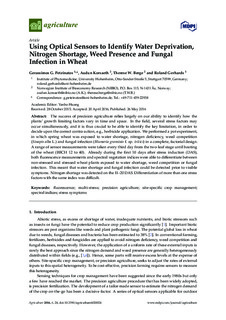| dc.contributor.author | Peteinatos, Gerassimos G. | |
| dc.contributor.author | Korsæth, Audun | |
| dc.contributor.author | Berge, Therese W. | |
| dc.contributor.author | Gerhards, Roland | |
| dc.date.accessioned | 2017-11-22T20:16:17Z | |
| dc.date.available | 2017-11-22T20:16:17Z | |
| dc.date.created | 2016-08-02T10:20:02Z | |
| dc.date.issued | 2016-05-26 | |
| dc.identifier.citation | Agriculture. 2016, 6 (2), . | nb_NO |
| dc.identifier.issn | 2077-0472 | |
| dc.identifier.uri | http://hdl.handle.net/11250/2467656 | |
| dc.description.abstract | The success of precision agriculture relies largely on our ability to identify how the plants’ growth limiting factors vary in time and space. In the field, several stress factors may occur simultaneously, and it is thus crucial to be able to identify the key limitation, in order to decide upon the correct contra-action, e.g., herbicide application. We performed a pot experiment, in which spring wheat was exposed to water shortage, nitrogen deficiency, weed competition (Sinapis alba L.) and fungal infection (Blumeria graminis f. sp. tritici) in a complete, factorial design. A range of sensor measurements were taken every third day from the two-leaf stage until booting of the wheat (BBCH 12 to 40). Already during the first 10 days after stress induction (DAS), both fluorescence measurements and spectral vegetation indices were able to differentiate between non-stressed and stressed wheat plants exposed to water shortage, weed competition or fungal infection. This meant that water shortage and fungal infection could be detected prior to visible symptoms. Nitrogen shortage was detected on the 11–20 DAS. Differentiation of more than one stress factors with the same index was difficult. | nb_NO |
| dc.language.iso | eng | nb_NO |
| dc.publisher | MDPI AG | nb_NO |
| dc.rights | Navngivelse 4.0 Internasjonal | * |
| dc.rights.uri | http://creativecommons.org/licenses/by/4.0/deed.no | * |
| dc.subject | fluorescence | nb_NO |
| dc.subject | multi-stress | nb_NO |
| dc.subject | precision agriculture | nb_NO |
| dc.subject | site-specific crop management | nb_NO |
| dc.subject | spectral indices | nb_NO |
| dc.subject | stress symptoms | nb_NO |
| dc.title | Using Optical Sensors to Identify Water Deprivation, Nitrogen Shortage, Weed Presence and Fungal Infection in Wheat | nb_NO |
| dc.type | Journal article | nb_NO |
| dc.type | Peer reviewed | nb_NO |
| dc.description.version | publishedVersion | nb_NO |
| dc.rights.holder | © 2016 by the authors; licensee MDPI, Basel, Switzerland | nb_NO |
| dc.subject.nsi | VDP::Landbruks- og Fiskerifag: 900::Landbruksfag: 910::Planteforedling, hagebruk, plantevern, plantepatologi: 911 | nb_NO |
| dc.source.pagenumber | 21 | nb_NO |
| dc.source.volume | 6 | nb_NO |
| dc.source.journal | Agriculture | nb_NO |
| dc.source.issue | 2 | nb_NO |
| dc.identifier.doi | 10.3390/agriculture6020024 | |
| dc.identifier.cristin | 1370044 | |
| dc.relation.project | Norges forskningsråd: 207829 | nb_NO |
| cristin.ispublished | true | |
| cristin.fulltext | original | |
| cristin.qualitycode | 1 | |

